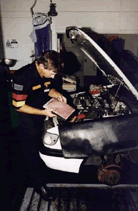What is Motor vehicle pollution?
Motor Vehicle pollutants cause prompt and long haul consequences for the climate. Vehicle debilitates transmit a large number of gases and strong matter, causing an unnatural weather change, corrosive downpour, and hurting the climate and human wellbeing. Motor clamor and fuel spills likewise cause contamination. Vehicles, trucks and different types of transportation are the single biggest supporter of air contamination in the United States, however vehicle proprietors can lessen their vehicle’s consequences for the climate.
Do you know that:
over 99.4% of all contamination gases are invisible
your vehicle discharges emissions in any event, while it’s stopping
different vapor from petroleum and ointments vanish high up.
Pollutants produced by vehicle depletes include carbon monoxide, hydrocarbons, nitrogen oxides, particles, unpredictable natural mixtures and sulfur dioxide. Hydrocarbons and nitrogen oxides respond with daylight and warm temperatures to frame ground-level ozone. Ground-level ozone, a primary fixing in exhaust cloud, can lead to upper respiratory issues and lung harm.
How big is the problem?
Research shows that engine vehicles are liable for around 70% of south-east Queensland’s air contamination. Except if we as a whole beginning lessening vehicle use and engine vehicle contamination, this level is set to decisively increment.
Free exploration led by the Department of Transport and Main Roads distinguished air quality as a central issue among individuals in south-east Queensland. A typical vehicle makes very nearly 6 tons of toxins every year. That is roughly identical to the heaviness of 7 little vehicles.
Notwithstanding this, current air quality is generally great — however that doesn’t mean it will stay that way later on.
South-east Queensland’s populace is anticipated to arrive at 3 million in the following 15 years. On the off chance that vehicle use keeps on rising, scientists foresee we will twofold the quantity of vehicle kilometers went over a similar period.
Delivering a few outflows (and causing some air pollution) is an inescapable side-effect of using an engine vehicle. In any case, there are straightforward advances you can take to ensure your vehicle’s emanation levels are all around as low as could be expected. To figure out more, read how you can assist with decreasing your vehicle’s emissions.
How can the problem be fixed?

According to the Federal Office of Road Safety’s National In-Service Vehicle Emissions Study, if all vehicles were tuned correctly there would be up to:
- 16% less tailpipe hydrocarbon emissions
- 26% less tailpipe carbon monoxide emissions
- 9% less nitrogen oxides emissions.
The study also revealed that on average, maintenance to polluting vehicles does not require the replacement of major or expensive parts. Tuning is mainly limited to:
- replacing points and air filter
- replacing fuel filter
- replacing oil and oil filter
- checking spark plug condition and gap—adjusting or replacing
- checking distributor condition and operation and adjusting
- checking and adjusting idle mix and speed
- checking and replacing spark plug and distributor leads
- checking and replacing hoses and other minor items in fuel/electrical/emission control system
- examining vehicle diagnostics and replacing faulty components.



